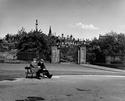 While Glasgow's population grew from 784,500 in 1911 to one million in 1921 – where it remained until 1965 – there was little addition to the stock of burial grounds. The 19th century developers had set aside enough space for the expanding city and its dead and only Cardonald (1922), Glenduffhill (1934) and Carmunnock cemeteries (1938) were constructed in this period. Cremation also continued to grow in popularity from fewer than one per cent of disposals to around thirty-three per cent reducing the demand for grave space by one third. Following the Church of Scotland (Property and Endowments) Act of 1925, those church yards not already belonging to the local authority were transferred into its ownership setting Glasgow Corporation on the road to being by far the biggest provider of burials and cremations.
While Glasgow's population grew from 784,500 in 1911 to one million in 1921 – where it remained until 1965 – there was little addition to the stock of burial grounds. The 19th century developers had set aside enough space for the expanding city and its dead and only Cardonald (1922), Glenduffhill (1934) and Carmunnock cemeteries (1938) were constructed in this period. Cremation also continued to grow in popularity from fewer than one per cent of disposals to around thirty-three per cent reducing the demand for grave space by one third. Following the Church of Scotland (Property and Endowments) Act of 1925, those church yards not already belonging to the local authority were transferred into its ownership setting Glasgow Corporation on the road to being by far the biggest provider of burials and cremations.
 In this period, cemetery landscapes changed from mimicking the pleasure grounds of country estates to a far more utilitarian grid, designed for easy maintenance. Memorials also became more uniform as monumental masons offered standard stones that were sold from catalogues then machine cut and lettered. Another source of standardised memorials was the government which paid for small but distinctive stones for some of those killed in the two World Wars. The wholesale removal of ornamental cast iron from streets and gardens during the World War Two also affected cemeteries where cages – originally provided to protect the corpse from grave-robbers – curbs and railings were taken away, often significantly reducing the amount of architectural detailing on individual graves.
In this period, cemetery landscapes changed from mimicking the pleasure grounds of country estates to a far more utilitarian grid, designed for easy maintenance. Memorials also became more uniform as monumental masons offered standard stones that were sold from catalogues then machine cut and lettered. Another source of standardised memorials was the government which paid for small but distinctive stones for some of those killed in the two World Wars. The wholesale removal of ornamental cast iron from streets and gardens during the World War Two also affected cemeteries where cages – originally provided to protect the corpse from grave-robbers – curbs and railings were taken away, often significantly reducing the amount of architectural detailing on individual graves.